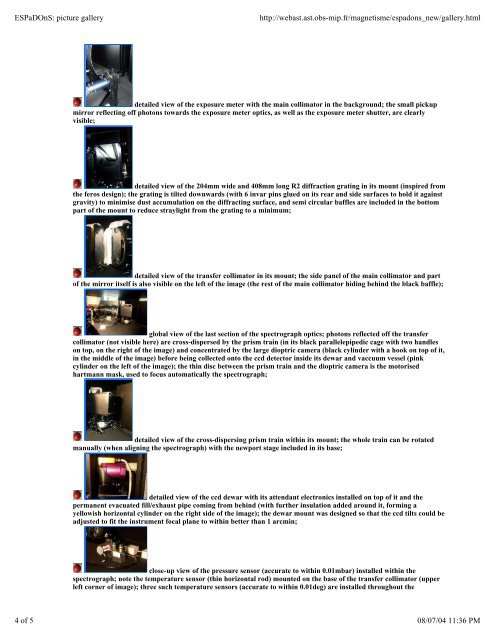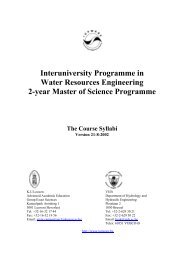CFHT operating manual - Homepage Usask
CFHT operating manual - Homepage Usask
CFHT operating manual - Homepage Usask
Create successful ePaper yourself
Turn your PDF publications into a flip-book with our unique Google optimized e-Paper software.
ESPaDOnS: picture gallery http://webast.ast.obs-mip.fr/magnetisme/espadons_new/gallery.html<br />
detailed view of the exposure meter with the main collimator in the background; the small pickup<br />
mirror reflecting off photons towards the exposure meter optics, as well as the exposure meter shutter, are clearly<br />
visible;<br />
detailed view of the 204mm wide and 408mm long R2 diffraction grating in its mount (inspired from<br />
the feros design); the grating is tilted downwards (with 6 invar pins glued on its rear and side surfaces to hold it against<br />
gravity) to minimise dust accumulation on the diffracting surface, and semi circular baffles are included in the bottom<br />
part of the mount to reduce straylight from the grating to a minimum;<br />
detailed view of the transfer collimator in its mount; the side panel of the main collimator and part<br />
of the mirror itself is also visible on the left of the image (the rest of the main collimator hiding behind the black baffle);<br />
global view of the last section of the spectrograph optics; photons reflected off the transfer<br />
collimator (not visible here) are cross-dispersed by the prism train (in its black parallelepipedic cage with two handles<br />
on top, on the right of the image) and concentrated by the large dioptric camera (black cylinder with a hook on top of it,<br />
in the middle of the image) before being collected onto the ccd detector inside its dewar and vaccuum vessel (pink<br />
cylinder on the left of the image); the thin disc between the prism train and the dioptric camera is the motorised<br />
hartmann mask, used to focus automatically the spectrograph;<br />
detailed view of the cross-dispersing prism train within its mount; the whole train can be rotated<br />
<strong>manual</strong>ly (when aligning the spectrograph) with the newport stage included in its base;<br />
detailed view of the ccd dewar with its attendant electronics installed on top of it and the<br />
permanent evacuated fill/exhaust pipe coming from behind (with further insulation added around it, forming a<br />
yellowish horizontal cylinder on the right side of the image); the dewar mount was designed so that the ccd tilts could be<br />
adjusted to fit the instrument focal plane to within better than 1 arcmin;<br />
close-up view of the pressure sensor (accurate to within 0.01mbar) installed within the<br />
spectrograph; note the temperature sensor (thin horizontal rod) mounted on the base of the transfer collimator (upper<br />
left corner of image); three such temperature sensors (accurate to within 0.01deg) are installed throughout the<br />
4 of 5 08/07/04 11:36 PM

















